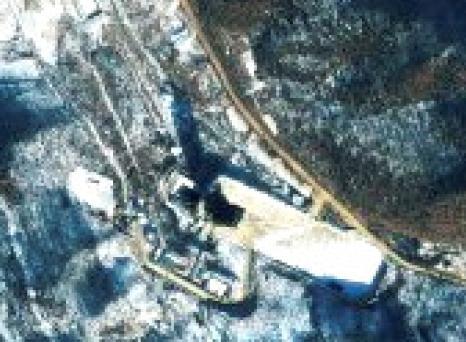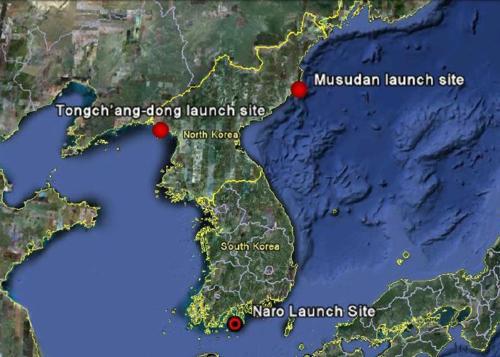
Tongcha’ng launch site (yonhap News)
Last week press stories announced that North Korea is finishing a second launch site for long-range rockets, which is bigger and more sophisticated than its original site. Tim Brown of globalsecurity.org found the new site, called Tongch’ang-dong after a nearby town, using satellite images in 2008 and has been following its progress since then.
Previously, North Korea launched its multi-stage rockets from a site in Musudan-ri on the east coast of the country, near the Sea of Japan. The most recent launch from that site was in April 2009 when the Unha-2 launcher failed to place a small satellite into orbit. The new launch site is instead located on the west coast of the country (see Figure 1).

Figure 1: This map shows the location of North Korea’s original launch site (Musudan) and its new site (Tonch’ang-dong), as well as South Korea’s Naro launch site.
In addition to much improved roads and facilities, several reports state that the new site has a significantly taller launch tower than the old site—50 versus 32 meters. (Brown suggests a more modest increase of 8 meters to a total height of 40 meters.)
Two interesting questions raised by the new site are: why the new location, and why the larger tower?
Why the New Location?
Why would North Korea build a new launch site on the west coast rather than modify its existing site? Speculation on this point abounds, including:
(a) The new site is relatively close (100km) to the Sanum-dong long-range missile development center in Pyongyang, simplifying the transfer of missiles to the site.
(b) It is only 70 kilometers from the Yongbyon nuclear complex, and could therefore “reduce the time and cost for delivering nuclear warheads to the new launch site” if North Korea develops a warhead that can be delivered by long-range missile.
(d) It reduces the incentive for an attack on the site since it is less than 50 kilometers from the border with China.
(e) It would reduce Japanese objections to rockets that overfly the Japan since they would be launched from further west and would therefore be at a somewhat higher altitude as they passed over Japan.
(f) The location would allow North Korea to launch heavier payloads.
Both (e) and (f) can be discounted. My analysis of the Unha launch indicates it passed over the northern part of Japan at an altitude of some 400 kilometers. Launching from 400 kilometers further west, which is the distance between the two launch sites, would only have increased that altitude by about 50 kilometers, which is unlikely to affect Japan’s view of an overflight. Point (f) is simply incorrect.
The other points may be incentives for a new site, since the Musudan-ri site is relatively isolated.
But the most compelling reason to me is the fact that this location allows North Korea to launch south and avoid overflying any country during its boost phase (see Figure 2). Pyongyang can argue this represents a more responsible approach to flight testing, and that it removes Japan’s objections about overflights. Attempting to launch south from its original launch site would overfly South Korea. Moreover, since the flight path would be very similar to the trajectory that South Korean launches follow, Pyongyang can argue that objections to its launches represents an international double standard.

Figure 2: Launch paths from North and South Korea. The white line shows the eastward launch path of North Korea’s Unha-2 in 2009 from its original launch site. The yellow line shows the approximate path of South Korea’s 2009 and 2010 satellite launch attempts. The red line shows a similar path that launches from North Korea’s new launch site could follow.
Launching south rather than east is not optimal for putting satellites in orbit since by launching east the rocket gains speed from the rotation of the Earth (about 0.3 kilometers per second in North Korea’s case—about 4% of the amount needed to reach orbit). Indeed, North Korea’s Taepo-dong 1 (1998) and Unha-2 (2009) were both launched due east (see Figure 2).
Some may argue that building a site to launch south indicates it is not intended for satellite launches. But this argument is not compelling since Figure 2 shows that South Korea is also forced to launch satellites to the south because of the same geographic constraints. Other examples are even more extreme; for example, because of the local geography, Israel launches satellites westward, meaning that the Earth’s rotation actually works against its launches.
So geographic constraints can lead to sub-optimal launch direction, and the new site could plausibly be used either for launching either satellites or testing ballistic missiles.
Why a 50-meter Tower?
Assuming reports of a 50-meter tower are correct, what might this imply?
North Korea’s Unha-2 launcher was roughly 30 meters long. Since the tower at Musudan-ri where the Unha was launched is reportedly only slightly longer than this (32 meters), it suggests that a 50-meter tower could accommodate launchers well over 40 meters in length.
To put that in perspective it’s useful to compare these lengths to rockets that use similar fuels to the Unha-2, which include some Chinese and Russian missiles and space-launch vehicles. The Unha-2 is roughly the same size and mass (roughly 80 tons) as the first Chinese space-launch vehicle, the Long March 1, which used similar technology to the Unha. The Long March 1 and Unha-2 are 2.25 and 2.4 meters in diameter, respectively.
The considerably more capable Long March 2 space launcher, as well as China’s DF-5 intercontinental-range ballistic missile, are only slightly longer than the Unha—32 to 33 meters. Their greater capability results from their larger diameter—3.35 meters—which allows them to carry much more fuel. As a result, these rockets have a much larger mass than the Unha—180 to 190 tons. The DF-5 can carry a three-ton warhead more than 10,000 kilometers. Similarly, the Soviet SS-18 ballistic missile, which also uses storable liquid fuel, is roughly the same size as the DF-5, with a length of 32 meters.
The more modern Chinese Long-March 3 and 4 space launchers, which can carry heavier satellites into orbit, also have diameters of 3.35 meters but are 42 meters long.
As a result, if North Korea follows a typical path for developing missiles, it would not need a 50-meter tower to launch a long-range ballistic missile.
In principle it could attempt to build a missile with significantly more fuel than the Unha by continuing to use a 2.4-meter first stage but increasing its length. However, lengthening the Unha by 10 meters would give a very large length-to-diameter ratio, which can lead to structural instabilities when subjected to the large forces during launch. So it seems unlikely that a stretched Unha would approach 40 meters in length, and would therefore not require a 50-meter tower.
Given this, it seems that a tower of this size would only be required if North Korea planned to eventually develop and launch a space-launch vehicle like modern Chinese vehicle
This may seem like a fantasy, and may well be one. But Pyongyang has long argued that it wants to develop and sell space-launch services. Building the tower may be one step of this process it can carry out any time soon.
Conclusion
The bottom line is that while North Korea may use its new launch site to develop ballistic missiles, neither its location nor the size of its tower seem to indicate that it was optimized for that purpose. In fact, both are consistent with its use for space launches.
